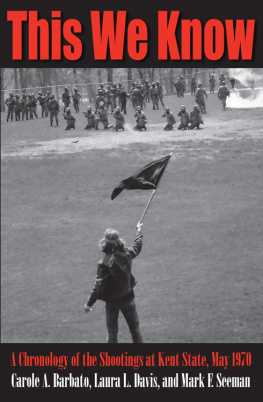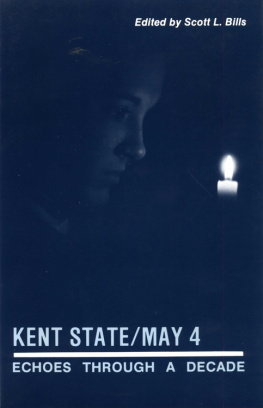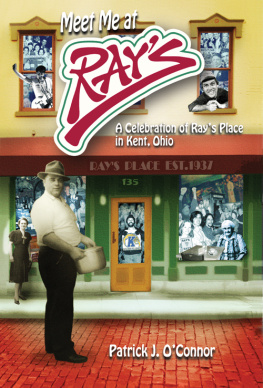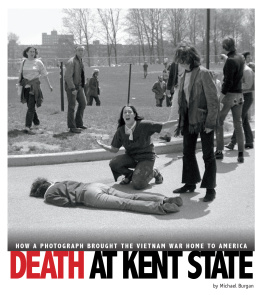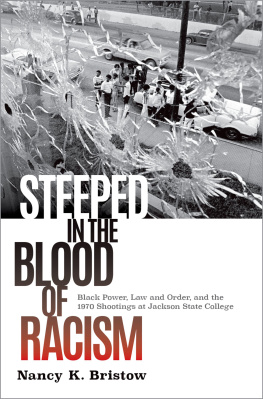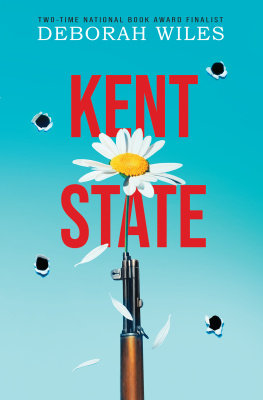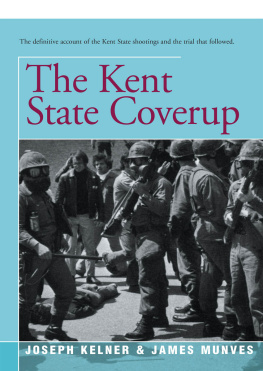Carole A. Barbato, Laura L. Davis,
and Mark F. Seeman
Cataloging information is available at the Library of Congress.
What happened on May 4, 1970? It is a story that continues to be written. Still, we have documented facts that fill out the chronology of the events at Kent Statethe four days in May that ended with members of the Ohio National Guard wounding nine Kent State students and fatally shooting Sandra Scheuer, Jeffrey Miller, Allison Krause, and William Schroeder. This We Know gathers well-established information from recorded accountsfrom the time they happened through what we have learned since.
While many know generally what happened, they are often surprised by the details. It is not a story in which what you think happened necessarily is what did happen. Common sense and logic do not fully explain the sequence. Think back to Philosophy 101 or The West Wing episode titled Post Hoc, Ergo Propter Hoc. The Latin phrase reveals the fallacy: Since this event occurred after that one, this event must have been caused by that one. Resisting the fallacy, we must remember that the dramatic events of May 1, 2, and 3 preceded May 4, but did not cause what happened on May 4. Windows were broken on Friday. A building burned on Saturday. A sit-in was staged on Sunday. However, these events did not cause guardsmen to fire their rifles on Monday.
As you find your path to historical understanding, words written by Allison Krause might provide a guide. On a history exam in 1970, she wrote: Dates and facts are not enough to show what happened in the past. It is necessary to delve into the human side of history to come up with the truth. History must be made relevant to the present to make it useful. Why did the Guard shoot on May 4, 1970, ending Allisons life and the lives of Bill, Sandy, and Jeff? Is that story relevant to you?
The Kent State University May 4 Visitors Center offers you the dates and facts of This We Know as an entre to understanding what happened in the past. Walk through that door to delve into the human side of history in the May 4 Visitors Center. Experience the struggle for social justice and generational divides that stood as a backdrop for the shootings at Kent State. Immerse yourself in what happened on May 4. Witness the worldwide impact of the event. Reflect on whether this history is of use today to help preserve the principles of democratic societies.
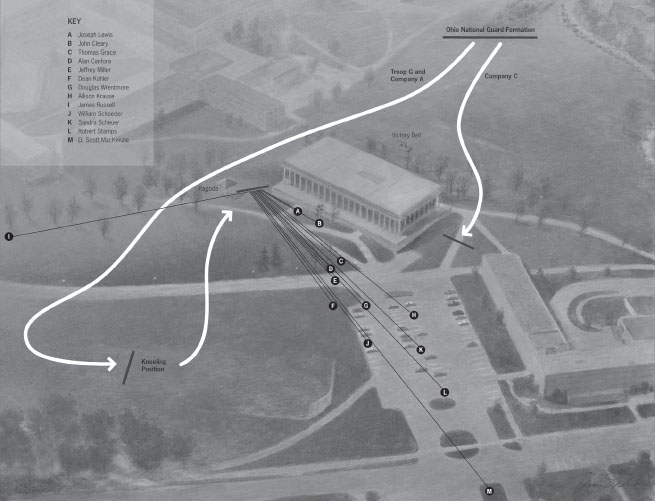
Site of the student rally and shootings on May 4, 1970. Curved lines trace the path of Ohio National Guard troops beginning at 12:05 P.M. on May 4, 1970. At 12:24, guardsmen turned 135 degrees at the Pagoda and twenty-eight fired, primarily toward students in the Prentice Hall parking lot. Map copyright Kent State University. Reprinted with permission.
I have concluded that the actions of the enemy in the last 10 days clearly endanger the lives of Americans who are in Vietnam now and would constitute an unacceptable risk to those who will be there after withdrawal of another 150,000. To protect our men who are in Vietnam, and to guarantee the continued success of our withdrawal and Vietnamization program, I have concluded that the time has come for action. We take this action not for the purpose of expanding the war into Cambodia but for the purpose of ending the war in Vietnam and winning the just peace we all desire.
These words, spoken by President Richard M. Nixon on Thursday, April 30, 1970, at 9:00 P.M ., represented to many an escalation of the war in Vietnam, not the de-escalation he had promised since 1968. The invasion of Cambodia was seen by many as a betrayal, a cataclysmic move that turned the War in Vietnam into the War in Indochina.
F RIDAY , M AY 1, 1970
On Friday, May 1, 1970, students at Kent State University, like thousands of others at hundreds of colleges and universities throughout the United States, participated in a protest against the U.S. invasion of Cambodia. While protests at some other colleges and universities were violent, this rally was impassioned but peaceful.
Kent State history graduate students Steve Sharoff and Chris Plant awoke early in the morning to plan a campus protest against Nixons announcement of the incursion into Cambodia. By 7:00 A.M. , they were distributing flyers announcing a rally at noon. Those present agreed to meet at noon on Monday, May 4, to determine if they should join other universities and colleges throughout America in a national student strike. The assembly began and ended peacefully.
Later that afternoon, Kent States Black United Students (BUS) held a rally on front campus to hear a speaker from Ohio State University talk about violence by law enforcement officials during demonstrations there. Black students advised their peers to stay away from campus activities that weekend. The short, forty-five-minute meeting disbanded peacefully. Upon hearing of the two peaceful protests, KSUs president, Robert I. White, left for Iowa, where he was to sit on the American College Testing board of trustees meeting on Sunday and take some time while there to visit with family.
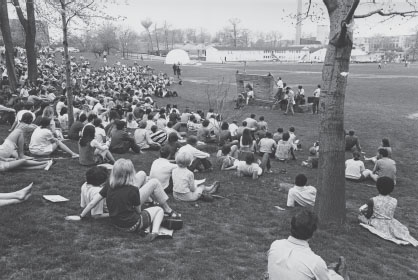
On Friday, May 1, Kent State students protest the invasion of Cambodia by symbolically burying a copy of the U.S. Constitution at the Victory Bell on the Commons. Reprinted with permission of Kent State University Special Collections and Archives.
Friday evening was one of the first warm Friday nights of the spring.
The Akron Beacon Journal Special Report noted that Patrolman Robert Defluiter of the Kent Police Department said that between 11:27 and 11:41 P.M. he watched young demonstrators shouting Get out of town, pigs! bombard two police cars with bottles, glasses and beer pitchers.
After consulting with Kents police chief, Roy Thompson, Mayor Leroy Satrom declared a state of civil emergency at 12:20 A.M. and ordered all bars to be closed. He set a curfew of 11:00 P.M. for the city and 1:00 A.M. for the campus. Thompson and the Kent police enforced this order.
Some of the crowd from downtown were forced onto campus, where they were safe from police action. When a traffic accident left an electric worker strandedhanging on the traffic light at the corner of Lincoln and Main (the entrance to the Kent State campus)police and members of the crowd on the campus grounds worked together to assist the worker to safety.
Lieutenant Charles Barnette of the Ohio National Guard arrived at the city of Kent to talk with the mayor at 2:27 A.M. James Best, a Kent State political science professor, concluded, Frustration over the Cambodian invasion, anger because they were turned out of bars, and the sting of tear gas turned what might have otherwise been a relatively harmless release of emotion into an ugly incident.

